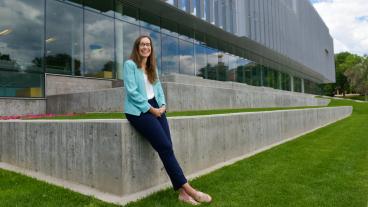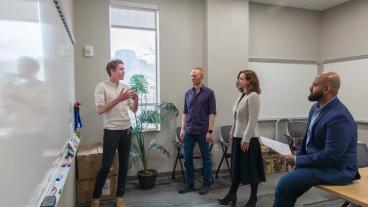Nearly 80 percent of all gold produced in the U.S. comes from Carlin-type deposits in northern Nevada, but scientists still don’t agree on how they came to be.
Elizabeth Holley, assistant professor of mining engineering at Colorado School of Mines, has received a National Science Foundation CAREER award to tackle that scientific debate. Holley’s project, “Did Carlin-type Gold Come From Magmas?”, which began in January, will receive $534,546 over five years.
“Despite more than 50 years of production, we don't completely understand the geologic processes that formed these deposits. The most contentious debate is whether or not the gold came from magmatic fluids,” Holley said. “If we could determine which processes, such as magmatism, were key to gold mineralization, mineral exploration efforts could target sites where these processes have occurred. Currently, it’s difficult to say whether Carlin-type deposits formed outside of Nevada, because we don’t know which ingredients were necessary.”
Instead of focusing on the most famous deposits on the Carlin trend, Holley’s innovative approach is to examine the Battle Mountain district in Nevada, a less-studied region with potentially clearer links to magmatism. The Battle Mountain district contains porphyry and skarn-type gold deposits known to have formed in association with magmatic activity, as well as some smaller deposits with Carlin-like characteristics.
Holley and her team will employ geochronology and thermochronology – the dating of magmatic intrusions and heating events – to try to tie the deposits to the ages of magmatism. Holley’s team will also look at the signature of the mineralizing fluids, using stable isotopes and fluid inclusions to see if they can get a “magmatic fingerprint” on the fluids that caused the gold mineralization.
“The traditional approach has been to examine the Carlin-type deposits themselves, where any link to magmatism would be hard to identify,” she said. “We’re taking the opposite tactic by starting with deposits that clearly have a magmatic signature and working outward to more distal environments where that signature may be more subtle.”
By collaborating with industry partners who are mining and exploring for gold in the district, Holley and her team will be able to examine sites that are ideal for testing their hypotheses but where very little scientific information has previously been available. The analytical work will be done in conjunction with researchers at the U.S. Geological Survey and the University of Illinois at Urbana-Champaign. The study builds on pilot data from current Mines graduate students Dante Huff and Justin Lowe and Mines alumnus Matt Fithian ‘15.
As part of the project, Holley will also conduct educational outreach aimed at increasing student interest in mineral exploration and mining.
“We’re not training very many mineral exploration and mining professionals in the United States. A lot of programs have disappeared in the last several decades and we’re not meeting the industry demand. Mining is an important part of the U.S. economy,” Holley said. “The National Resource Council task force put together a list of recommendations to increase the number of trained professionals we’re graduating – one is innovative curricula and another is earlier engagement.”
In partnership with the Colorado Mining Association and Relay Graduate School of Education Dean Alice Waldron, Holley will invite K-12 teachers from around the U.S. to join her team in Colorado for the CMA Education Foundation’s All About Mining teacher course. Participating educators will also attend a special workshop on research and mineral exploration and receive continued engagement from Holley’s team after returning to their home classrooms. In addition, the grant will provide support for graduate students in Holley’s Mining Geology course to gain hands-on experience during field trips to the study sites in Nevada.
“Mining happens in an increasingly complex social and environmental context and we’re all consumers,” she said. “An understanding of the science behind mineral deposits is important for everybody. We all need to make educated consumer choices.”
A Mines alumna, Holley joined the Mines faculty after completing her Ph.D. in geology in 2012. She holds a master’s degree in geochemistry from the University of Otago, New Zealand, and a bachelor’s degree in geology from Pomona College.
CONTACT
Emilie Rusch, Public Information Specialist, Communications and Marketing | 303-273-3361 | erusch@mines.edu
Mark Ramirez, Managing Editor, Communications and Marketing | 303-273-3088 | ramirez@mines.edu



